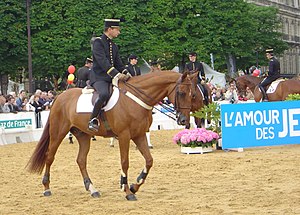Tack is equipment or accessories equipped on horses and other equines in the course of their use as domesticated animals. This equipment includes such items as saddles, stirrups, bridles, halters, reins, bits, and harnesses. Equipping a horse is often referred to as tacking up, and involves putting the tack equipment on the horse. A room to store such equipment, usually near or in a stable, is a tack room.
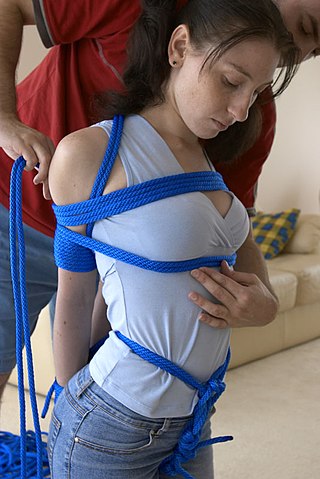
Bondage in BDSM, is the activity of tying or restraining people using equipment such as chains, cuffs, or collars for mutual erotic pleasure. According to the Kinsey Institute, 12% of females and 22% of males respond erotically to BDSM.
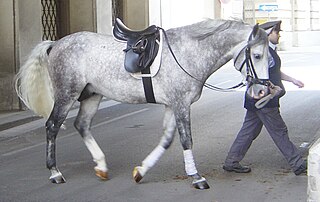
English saddles are used to ride horses in English riding disciplines throughout the world. The discipline is not limited to England, the United Kingdom in general or other English-speaking countries. This style of saddle is used in all of the Olympic and International Federation for Equestrian Sports (FEI) equestrian disciplines, except for the newly approved FEI events of equestrian vaulting and reining. Most designs were specifically developed to allow the horse freedom of movement, whether jumping, running, or moving quickly across rugged, broken country with fences. Unlike the western saddle or Australian Stock Saddle, there is no horn or other design elements that stick out above the main tree of the saddle.

Western saddles are used for western riding and are the saddles used on working horses on cattle ranches throughout the United States, particularly in the west. They are the "cowboy" saddles familiar to movie viewers, rodeo fans, and those who have gone on trail rides at guest ranches. This saddle was designed to provide security and comfort to the rider when spending long hours on a horse, traveling over rugged terrain.

Sidesaddle riding is a form of equestrianism that uses a type of saddle which allows female riders to sit aside rather than astride an equine. Sitting aside dates back to antiquity and developed in European countries in the Middle Ages as a way for women in skirts to ride a horse in a modest fashion while also wearing fine clothing. It has retained a specialty niche even in the modern world.

A bridle is a piece of equipment used to direct a horse. As defined in the Oxford English Dictionary, the "bridle" includes both the headstall that holds a bit that goes in the mouth of a horse, and the reins that are attached to the bit. It provides additional control and communication through rein pressure.

Longeing or lungeing is a technique for training and exercising horses. It is also a critical component of the sport of equestrian vaulting.

A surcingle is a strap made of leather or leather-like synthetic materials such as nylon or neoprene, sometimes with elastic, that fastens around the horse's girth.
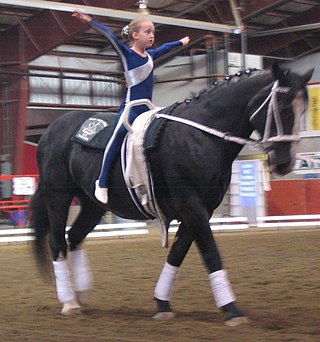
Side reins are equipment used when longeing a horse, running from the bit of the bridle to the saddle or surcingle. As a horse training tool, they encourage flexion and softness in the horse's mouth. For longe line work with a rider up who does not carry ordinary riding reins, they help calm and settle the animal. However, they are a tool best used by experienced handlers; used improperly they may unduly restrict the horse's movement or cause an accident.

A crupper is a piece of tack used on horses and other equids to keep a saddle, harness or other equipment from sliding forward.
A martingale is any of several designs of tack that are used on horses to control head carriage. Martingales may be seen in a wide variety of equestrian disciplines, both riding and driving. Rules for their use vary widely; in some disciplines they are never used, others allow them for schooling but not in judged performance, and some organizations allow certain designs in competition.
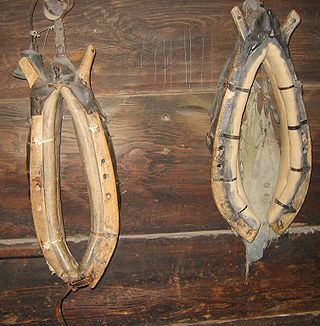
A horse collar is a part of a horse harness that is used to distribute the load around a horse's neck and shoulders when pulling a wagon or plough. The collar often supports and pads a pair of curved metal or wooden pieces, called hames, to which the traces of the harness are attached. The collar allows the horse to use its full strength when pulling, essentially enabling the animal to push forward with its hindquarters into the collar. If wearing a yoke or a breastcollar, the horse had to pull with its less-powerful shoulders. The collar had another advantage over the yoke as it reduced pressure on the horse's windpipe.
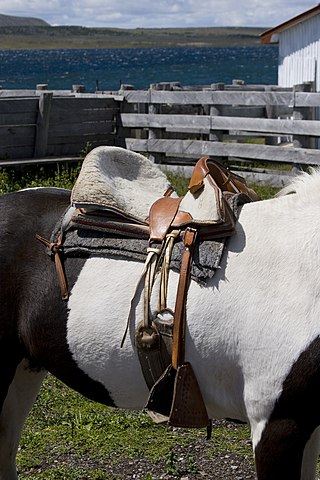
A girth, sometimes called a cinch, is a piece of equipment used to keep the saddle in place on a horse or other animal. It passes under the barrel of the equine, usually attached to the saddle on both sides by two or three leather straps called billets. Girths are used on Australian and English saddles, while western saddles and many pack saddles have a cinch, which is fastened to the saddle by a single wide leather strap on each side, called a latigo.
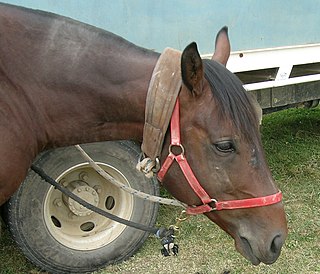
An animal collar is a device that attaches to the neck of an animal to allow it to be harnessed or restrained.

Draw reins and running reins are pieces of riding equipment used for training that use the mechanical advantage of a 'single movable pulley' to cause the horse to bring its head down and inward. While a regular rein is the strap that attaches to the bit and is held by the rider, these types of reins slide through the bit ring, adding leverage to the rider's hands and arms, allowing the rider to force the horse's head into a desired position.

A saddle is a supportive structure for a rider of an animal, fastened to an animal's back by a girth. The most common type is equestrian. However, specialized saddles have been created for oxen, camels and other animals. It is not known precisely when riders first began to use some sort of padding or protection, but a blanket attached by some form of surcingle or girth was probably the first "saddle", followed later by more elaborate padded designs. The solid saddle tree was a later invention, and though early stirrup designs predated the invention of the solid tree, the paired stirrup, which attached to the tree, was the last element of the saddle to reach the basic form that is still used today. Today, modern saddles come in a wide variety of styles, each designed for a specific equestrianism discipline, and require careful fit to both the rider and the horse. Proper saddle care can extend the useful life of a saddle, often for decades. The saddle was a crucial step in the increased use of domesticated animals, during the Classical Era.

The Australian stock saddle is a saddle in popular use all over the world for activities that require long hours in the saddle and a secure seat. The saddle is suitable for cattle work, starting young horses, everyday pleasure riding, trail riding, endurance riding, polocrosse and is also used in Australian campdrafting competitions and stockman challenges.
Horse harness is a device that connects a horse to a vehicle or another type of load.

Breeching ( "britching") is a strap around the haunches of a draft, pack or riding animal. Both under saddle and in harness, breeching engages when an animal slows down or travels downhill and is used to brake or stabilize a load.

A harness saddle is an element of horse harness which supports the weight of shafts or poles attaching a vehicle to a horse. Like other types of saddle, it lies on the horse's back directly behind the withers, often has an internal supportive framework , and usually is secured on either side by a girth passing beneath the horse. Unlike riding saddles, it is an integral part of the harness and is not used as stand-alone equipment.





